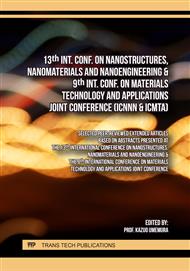[1]
Y. Lai, Y. Wang, J. Cheng, X. Chen, Q. Liu, Review of constraints and critical success factors of developing urban underground space, Undergr. Space. Vol. 12 (2023), pp.137-155.
DOI: 10.1016/j.undsp.2023.03.001
Google Scholar
[2]
Y. Yuan, S. Wang, P. Tan, H. Zhu, Mechanical performance and shear constitutive model study of a new high-capacity polyurethane elastomeric bearing, Constr. Build. Mater. Vol. 232 (2020), p.117227.
DOI: 10.1016/j.conbuildmat.2019.117227
Google Scholar
[3]
S. Wang, Y. Yuan, P. Tan, H. Zhu, K. Luo, Experimental study on mechanical properties of casting high-capacity polyurethane elastomeric bearings, Constr. Build. Mater. Vol. 265 (2020), p.120725.
DOI: 10.1016/j.conbuildmat.2020.120725
Google Scholar
[4]
H. Zhong, W. Yuan, X. Dang, X. Deng, Seismic performance of composite rubber bearings for highway bridges: Bearing test and numerical parametric study, Eng. Struct. Vol. 253 (2022), P. 113680.
DOI: 10.1016/j.engstruct.2021.113680
Google Scholar
[5]
X. Xu, Y. Yuan, S. Jin, Z. Han, C. Liang, H. Zhu, Study on polyurethane elastomer modification for improving low-temperature resistance of high-capacity polyurethane elastomeric bearing for bridges, Constr. Build. Mater. Vol. 347 (2022), P. 128625.
DOI: 10.1016/j.conbuildmat.2022.128625
Google Scholar
[6]
X. Xu, Y. Yuan, S. Wang, D. Zhang, H. Zhu, Effects of structural symmetry of introduced polyether diol on low temperature tolerance of laminated polyurethane bearings in bridges, Constr. Build. Mater. Vol. 400 (2023), p.132688.
DOI: 10.1016/j.conbuildmat.2023.132688
Google Scholar
[7]
Y. Tan, J. Dang, A. Igarashi, T. Himeno, Y. Hamada, Hysteretic restoring force model of high damping rubber bearings including thermo-mechanical coupled effect, Eng. Struct. Vol. 277 (2023), p.115449.
DOI: 10.1016/j.engstruct.2022.115449
Google Scholar
[8]
G. Huang, T. Yang, Z. He, L. Yu, H. Xiao, Polyurethane as a modifier for road asphalt: A literature review, Constr. Build. Mater. Vol. 356 (2022), p.129058.
DOI: 10.1016/j.conbuildmat.2022.129058
Google Scholar
[9]
Y. Dong, Y. Fu, C. He, D. Fang, A Hyper-Pseudoelastic Model of Cyclic Stress-Softening Effect for Rubber Composites, Polymers. Vol. 14 (2023), p.3033.
DOI: 10.3390/polym15143033
Google Scholar
[10]
S. Wang, Y. Yuan, P. Tan, Y. Li, W. Zheng, D. Zhang, Experimental study and numerical model of a new passive adaptive isolation bearing, Eng. Struct. Vol. 308 (2024), p.118044.
DOI: 10.1016/j.engstruct.2024.118044
Google Scholar
[11]
W. Liu, C. Xue, X. Long, Y. Ren, Z. Chen, W. Zhang, Highly flexible and multifunctional CNTs/TPU fiber strain sensor formed in one-step via wet spinning, J. Alloy. Compd. Vol. 948 (2023), p.169641.
DOI: 10.1016/j.jallcom.2023.169641
Google Scholar
[12]
J. Tang, Y. Wu, S. Ma, T. Yan, Z. Pan, Flexible strain sensor based on CNT/TPU composite nanofiber yarn for smart sports bandage, Compos. Part B-Eng. Vol. 232 (2022), p.109605.
DOI: 10.1016/j.compositesb.2021.109605
Google Scholar



